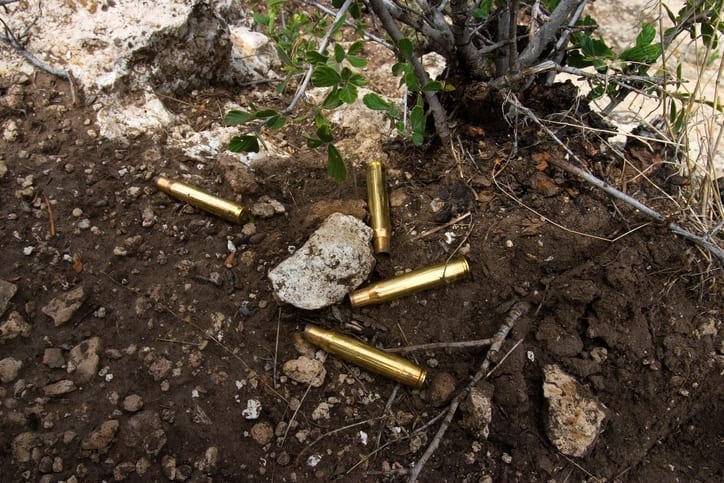
The Legalities of Firing Range Reclamation
The U.S. Environmental Protection Agency generally establishes nationwide protocols associated with the reclamation of a firing range. The EPA has established specific standards regarding the lead shot and bullets discharged for firearms at an operational firing range versus lead shot that remains when a firing range closes down or is otherwise abandoned. Most states have lead responsibilities for range closures.
Under existing EPA rules and regulations, lead shot/bullets on the grounds of a designated firing range is not considered an environmental hazardous waste. This is the case no matter how long a firing range may be in operation and no matter how long the discharged lead shot and bullets may remain in the soil or otherwise on the grounds of a firing range.
The status of the discharged lead shot or bullet changes when a firing range ceases operation. At that juncture in time, discharged lead shot and bullets can become classified as being an environmentally impacted solid waste. This occurs because when a fire range ceases operation, the discharged lead shot/bullet is deemed abandoned or discarded according to EPA standards. The lead shot/bullets remaining after a firing range ceases operation is subject to EPA and state regulatory cleanup requirements.
Recycling Lead Shot Encouraged but …
The EPA, and even the National Rifle Association (NRA), do state that they support the recycling of discharged lead shot/bullets on the grounds of a firing range. The reality is that the voluntary recycling of discharged lead shot/bullets on the grounds of a functioning fire range is not something that happens with enough frequency. Despite encouragement from both the EPA and NRA, recycling is not something that is occurring at the most desirable rate.
Actual Contamination Occurs from Discharged Lead Shot
Despite the technical determination by the EPA that discharged lead shot/bullets at an active firing range is not considered to be an environmental hazardous waste, in reality lead is a contaminant. Once fired, lead shot experiences at least some fragmentation. These fragmented particles can end up in water, not just the soil in which the discharged landed or entered.
In addition, nearly all rainfall contains at least some carbon dioxide and nitric oxide. In water, these two chemical combinations form at least some acid. The acid works to breakdown discharged lead shot or bullets, at least to some degree. This also can cause the lead shot to be contained in water, and not only in or on the ground.
Firing Range Cleanup and Reclamation
EPA and state standards must be followed when it comes to reclamation of a firing range and the removal and disposition of discharged lead shot/bullets. When it comes to reclamation, there are several factors that come into play.
First, the individuals involved in reclaiming the lead from a former firing range must be provided appropriate protective gear. Information on proper protective gear can be obtained either from the EPA, but also from the Occupational Safety and Health Administration. (OSHA)
Second, a cleanup and reclamation strategy must be designed that considers all areas at the firing range in which discharged lead shot or bullets might be found. Depending on how long the lead shot has been on or in the soil, reclamation may also require removal of the soil.
Third, as the discharged lead shot is collected and removed from the ground and elsewhere, it most properly be stowed for transit and disposition. Once again, the EPA and DOT delineate specific standards that must be followed when it comes to stowing discharged lead shot and when it comes to transport.
Finally, there are designated sites at which discharged lead shot/bullets can be recycled if the reclamation process is successful in generating clean recyclable materials. If not clean, lead shot/bullets would require disposal as a RCRA hazardous material.
Lead in Water
If lead that can be traced to the discharged lead shot on a firing range is detected in water, it is regulated under both the Clean Water Act and Safe Drinking Water Act when it comes to cleanup and remediation. This will require the assistance of remediation experts, due to the nature of cleanup of lead contamination from water.
Technically speaking, addressing lead contamination in water is governed by Water Quality-Based Effluent Limitations as established by the EPA and state. At its essence, the value is determined by the selection of the most stringent of the effluent limits. These limits do rely, in part, on standards adopted by the individual state.
Downtime for your range is a loss of revenue for you. No one can complete your project quicker than MT2! Contact us today for more information
Jessica Kane writes for Advance Online, a leading provider of web-based OSHA. DOT. and HAZWOPER training.


johnnybedford7@gmail.com
my boss had us to use leaf blowers, rakes, shovels ,paper mask,paper suits, to clean out the trap of 26,000 lb of rubber to get bullets out .it took 1 week and 4 guys to do it we all have lead poisoning my blood lead was 77 I have not worked in 4 weeks I have been sick no work comp he just buy my meds now I shake ,lost most of the time he has not gave me no money I have 2 kids 4 and a 6 year old what should I do I have worked 4 hem 10 years
We recommend that you immediately seek medical assistance if ill from lead poisoning. Additionally, you may need to bring your concerns to the Range Manager and Owner.